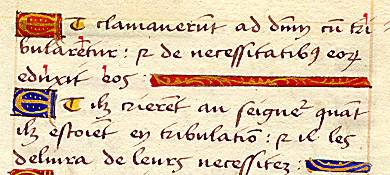Script Type : minuscule cursive
Date : late 15th or early 16th century
Location : France (presumably)
Function : book hand




























Distinctive letters: This bilingual text, which repeats the text of the Psalms in Latin and French in alternating verses, has been produced in a small and fully cursive Gothic script, but one which is clear and relatively easy to read. The letter forms are the same for the Latin and French text.
The letters b, l and h have curled ascenders, while d has the backward sloping Gothic form. The letter t is relatively tall and kinks to the right. The descender of q is straight, while that of g curls to the left. The letter z also has a curled descender.
The letter a is of simple form, with no loop above the body of the letter, while c has a minimalist, angular form and can be mistaken for r if you are not careful.
The tall form of s is long and tapering and extends both above and below the small letters, while the short form is simple with no closed loops. The more formal version of r has a crossed shape, but the simplified form seems to be more numerous, and is not just found after vowels.
The letters i and j are not differentiated, and i is sometimes, but not always, dotted with a fine diagonal slash. The letters u and v are also the same, but the alternative form is used for both when they appear at the beginning of a word.
The small letters composed of minims are all rather angular, so that it can be difficult sometimes to untangle the letters i, m,n ,u and v when they occur in combination.
There are no examples of k or w.
Pass the cursor slowly down the lines of text for a quick sample of how it reads. For a more detailed examination, proceed to the paleography exercises.
Paleography
exercises using Flash ![]()
Requires at least the Flash 5 plugin
If you are looking at this page without frames, there is more information about medieval writing to be found by going to the home page (framed) or the site map (no frames).